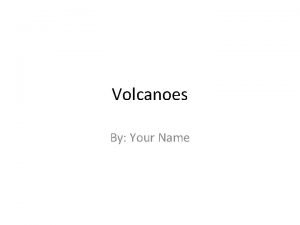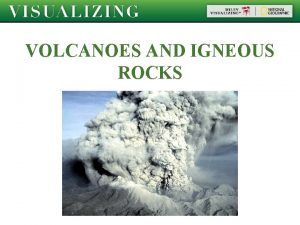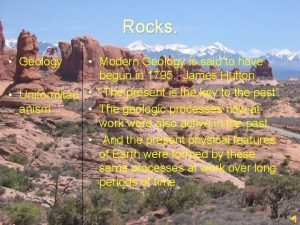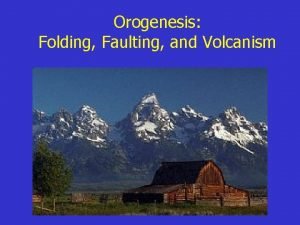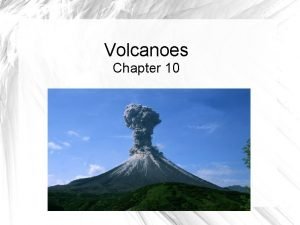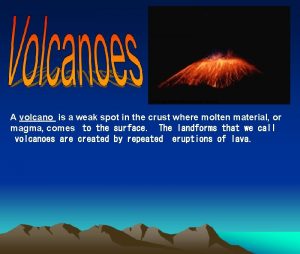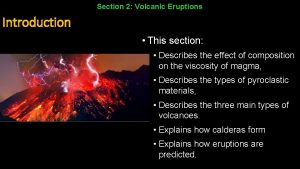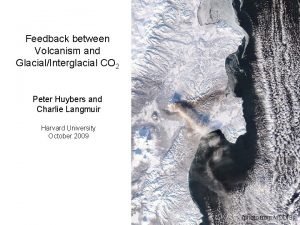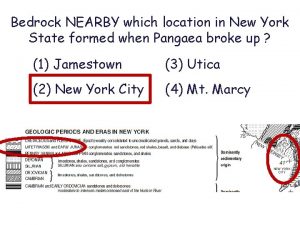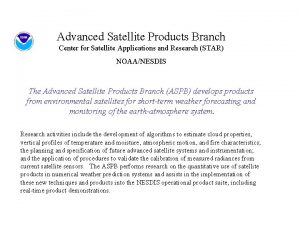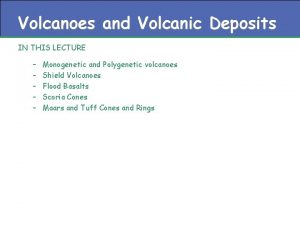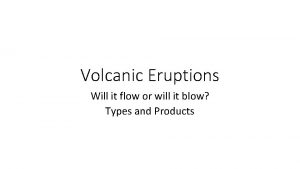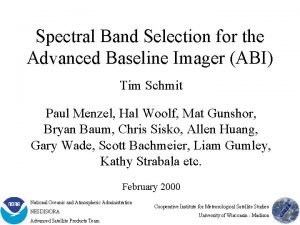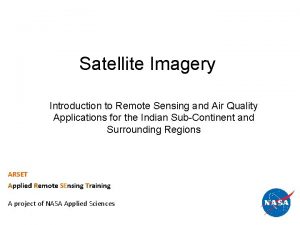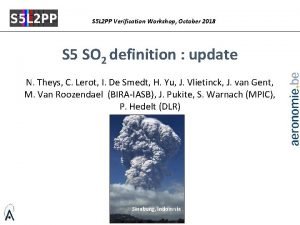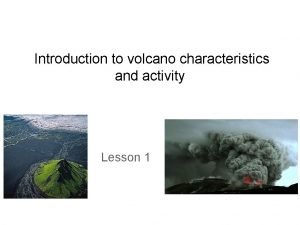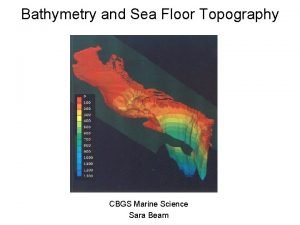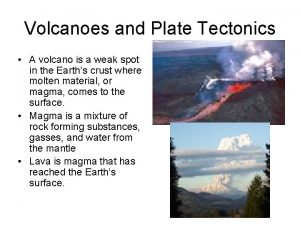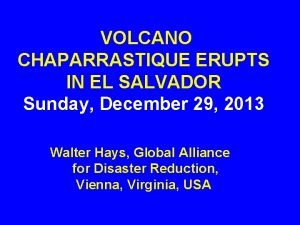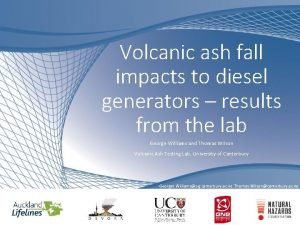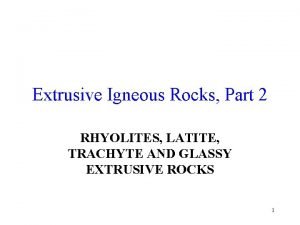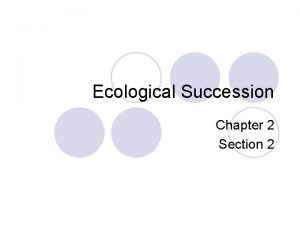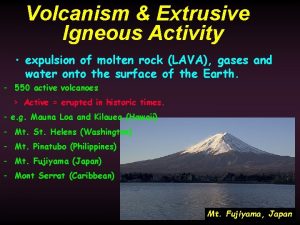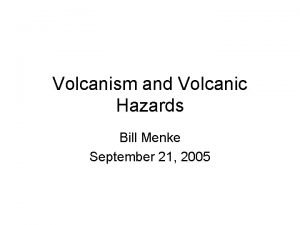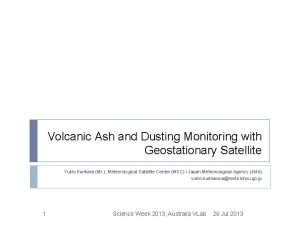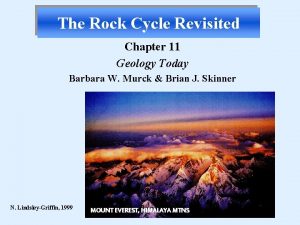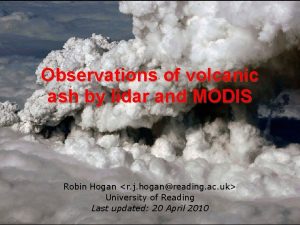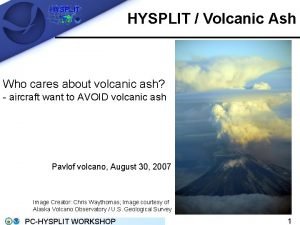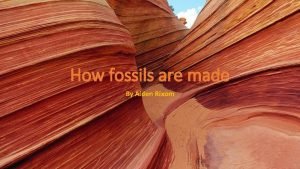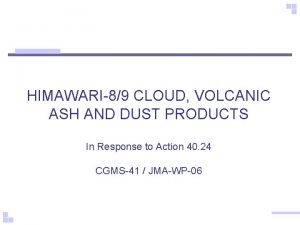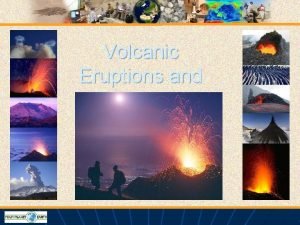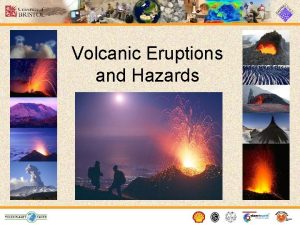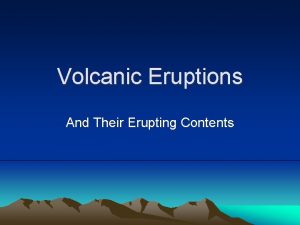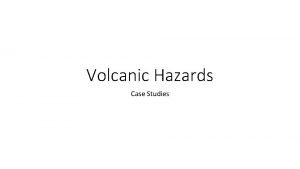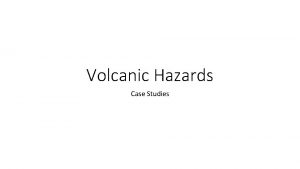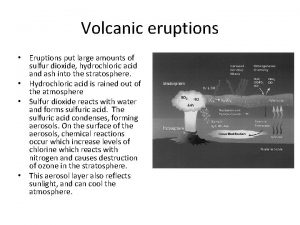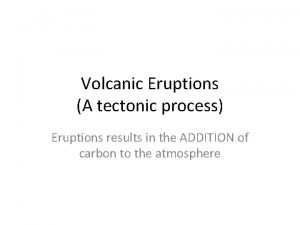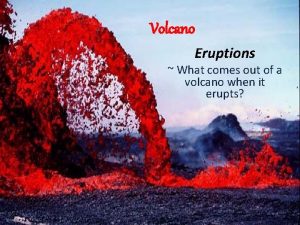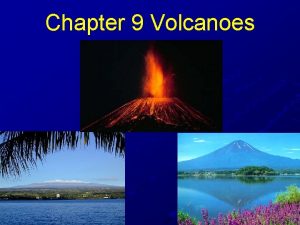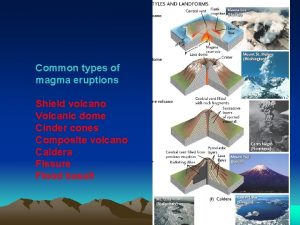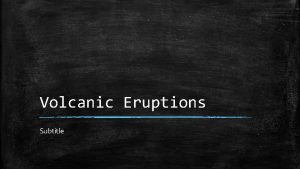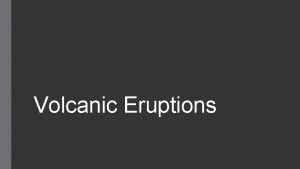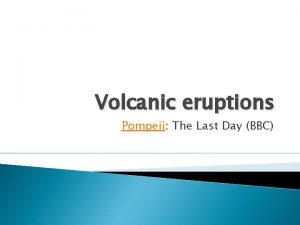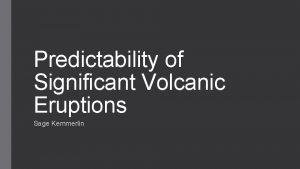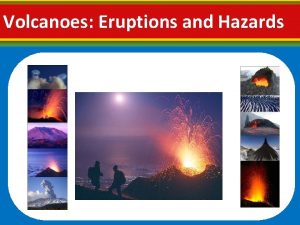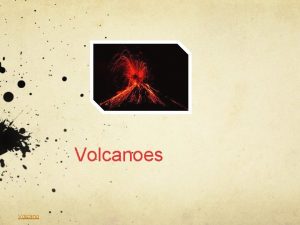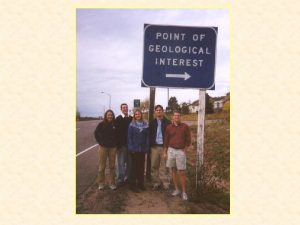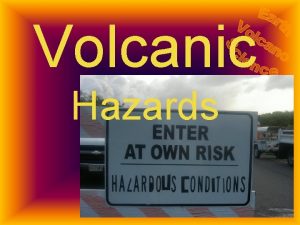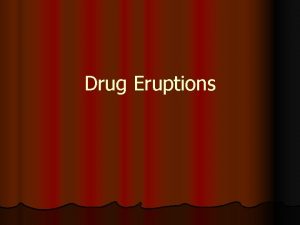Volcanic Eruptions and Hazards What is a volcano








































- Slides: 40

Volcanic Eruptions and Hazards

What is a volcano? vent • cone conduit A volcano is a vent or 'chimney' that connects molten rock (magma) from within the Earth’s crust to the Earth's surface. • The volcano includes the surrounding cone of erupted material. magma chamber

How and why do volcanoes erupt? • Hot, molten rock (magma) is buoyant (has a lower density than the surrounding rocks) and will rise up through the crust to erupt on the surface. – Same principle as hot air rising, e. g. how a hot air balloon works • When magma reaches the surface it depends on how easily it flows (viscosity) and the amount of gas (H 2 O, CO 2, S) it has in it as to how it erupts. • Large amounts of gas and a high viscosity (sticky) magma will form an explosive eruption! – Think about shaking a carbonated drink and then releasing the cap. • Small amounts of gas and (or) low viscosity (runny) magma will form an effusive eruption – Where the magma just trickles out of the volcano (lava flow).

Explosive Eruptions • Explosive volcanic eruptions can be catastrophic • Erupt 10’s-1000’s km 3 of magma • Send ash clouds >25 km into the stratosphere • Have severe environmental and climatic effects • Hazardous!!! Mt. Redoubt Above: Large eruption column and ash cloud from an explosive eruption at Mt Redoubt, Alaska

Explosive Eruptions • Three products from an explosive eruption – Ash fall – Pyroclastic flow video – Pyroclastic surge Pyroclastic flows on Montserrat, buried the capital city.

Direct measurements of pyroclastic flows are extremely dangerous!!!

Effusive Eruptions • Effusive eruptions are characterised by outpourings of lava on to the ground. Hawaii Courtesy of www. swisseduc. ch

Lava Flow • Pahohoe – a basaltic lava that has a smooth, billowy or ropy surface. At temperatures of 1100 to 1200 C video • A’a – basaltic lava that has a rough surface composed of broken lava blocks video

Lava Types • Felsic – rhyolitic or dacitic – Form lava spines or lava domes – Associated with pyroclastic flows – Very viscous – Composed of quartz and feldspar – Erupt at 650 to 750 C – Explosive eruptions

Lava Types • Intermediate – andesitic – Form andesite domes or block lavas – Erupt at 750 to 950 C – Less viscous than felsic lavas

Lava Types • Mafic – basaltic – Erupt at temperatures greater than 950 C – Contain a lot of Fe – Produce shield volcanoes – Low viscosity – Nonexplosive eruptions (effusive)

Volcano Monitoring and Hazard Mitigation

Volcanic Fatalities • 92, 000 Tambora, Indonesia 1815 • 36, 000 Krakatau, Indonesia 1883 • 29, 000 Mt Pelee, Martinique 1902 • 15, 000 Mt Unzen, Japan 1792 Courtesy of www. swisseduc. ch But, volcanoes cause fewer fatalities than earthquakes, hurricanes and famine. Why?

Volcanic Hazards • • • Courtesy of www. swisseduc. ch Pyroclastic flow Lahars/Mud flows Pyroclastic fall Lava flow Noxious Gas Earthquakes

Pyroclastic Flow • For example, eruption of Vesuvius in 79 AD destroyed the city of Pompeii

Pompeii (79 AD) On August 24, 79 AD Mount Vesuvius literally blew its top, erupting tons of molten ash, pumice and sulfuric gas miles into the atmosphere. Pyroclastic flows flowed over the city of Pompeii and surrounding areas.

Pompeii (79 AD) Pyroclastic flows of poisonous gas and hot volcanic debris engulfed the cities of Pompeii, Herculaneum and Stabiae suffocating the inhabitants and burying the buildings.

Vesuvius today • Vesuvius remains a hazardous volcano with heavily populated flanks: Naples Vesuvius Bay of Naples Courtesy of www. swisseduc. ch – around 1. 5 million people live in the city of Naples alone – Naples is situated approx. 30 km from Vesuvius – Pyroclastic flows can flow up to 100 km from source!

How do pyroclastic flows cause devastation?

Pyroclastic Flow - direct impact Courtesy of www. swisseduc. ch

Pyroclastic Flow - burial

Pyroclastic Flow - burns

Pyroclastic Flow - lahars • Hot volcanic activity can melt snow and ice • Melt water picks up rock and debris • Forms fast flowing, high energy torrents • Destroys all in its path

Pyroclastic Fall • Ash load – Collapses roofs – Brings down power lines – Kills plants – Contaminates water supplies – Respiratory hazard for humans and animals

Lava Flow • It is not just explosive volcanic activity that can be hazardous. Effusive (lava) activity is also dangerous.

Lava Flow - Heimaey, Iceland • Iceland, January 23, 1973. • Large fissure eruption threatened the town of Vestmannaeyjar.

Lava Flow - Heimaey, Iceland • The lava flows caught the inhabitants by surprise • Before the eruption was over, approximately onethird of the town of Vestmannaeyjer had been destroyed

So…. How do we minimize the risk of active volcanoes?

Volcano Monitoring Volcano Observatories are set up on all active volcanoes that threaten the human population. These are designed to monitor and potentially to predict the eruptive behaviour of the volcano in question.

Volcano Monitoring • Seismicity • Deformation • Gas Output – (on volcano and remote sensing techniques) These three things are the most important precursors to an eruption.

Seismic Activity • Earthquake activity commonly precedes an eruption – Result of magma pushing up towards the surface – Increase volume of material in the volcano shatters the rock – This causes earthquakes

Seismic Activity • Earthquake activity is measured by Seismographs – Seismographs are stationed on the flanks of the volcano – These record the frequency, duration and intensity of the earthquakes and report it back to the volcano observatory.

Deformation Monitoring • “Tiltmeters” are used to measure the deformation of the volcano – The tiltmeters measure changes in slope as small as one part per million. A slope change of one part per million is equivalent to raising the end of a board one kilometer long only one millimeter!

Deformation Monitoring • Tilltmeters can tell you when new material enters the magma chamber. A B Note the presence of earthquakes in relation to the deformation. Often it is a combination of events that fore -warns of an eruption.

Gas Monitoring • Commonly gas output from a volcano increases or changes composition before an eruption. – As magma rises to the surface it releases (exsolves) much of its gas content. – This can be measured

Gas Monitoring • Gas samples are collected from fumaroles and active vents. • Gas levels may also be monitored by remote sensing techniques

Play how hot spots are formed • Play

In Summary. . • Volcanoes are extremely hazardous. • However, the volcano can be studied, monitored and understood. • Each volcano is different, and offers a unique set of dangers • Plans may be emplaced to help control potential damage.

Post-lecture Question: • What should geologists do about volcanic eruptions in the future? 1. Study volcanoes to find out more about how and why they erupt 2. Monitor the volcanoes 3. Develop hazard mitigation plans 4. Understand the population around volcanoes, i. e. why do people choose to live near volcanoes? 5. Education

Lets Watch • Raging Planet: Volcanoes (Turn in questions at end of period)
 Taal volcano is an example of_______ volcano
Taal volcano is an example of_______ volcano Primary volcanic hazards
Primary volcanic hazards Volcanic hazards
Volcanic hazards Volcanic or plutonic rock
Volcanic or plutonic rock Define folding faulting and volcanic activity
Define folding faulting and volcanic activity Volcanic rocks and plutonic rocks
Volcanic rocks and plutonic rocks Lava plateau diagram
Lava plateau diagram Factor affecting volcanic eruption
Factor affecting volcanic eruption A whale bone that originally contained 200 grams
A whale bone that originally contained 200 grams Volcanic ash
Volcanic ash Volcanic ash
Volcanic ash Volcanic ash
Volcanic ash Volcanic features
Volcanic features Thin layers of volcanic ash act as excellent time markers
Thin layers of volcanic ash act as excellent time markers Volcanic ash
Volcanic ash Volcanic ash
Volcanic ash Volcanic ash
Volcanic ash Volcanic ash
Volcanic ash Volcanic ash
Volcanic ash Volcanic ash
Volcanic ash Volcanic ash
Volcanic ash Tephra in volcano
Tephra in volcano What are plutons that cause overlying rocks to bow upward
What are plutons that cause overlying rocks to bow upward Volcanic island arc map
Volcanic island arc map Volcanic island arc
Volcanic island arc Volcanic belts form along the boundaries of earth's
Volcanic belts form along the boundaries of earth's Volcanic ash
Volcanic ash Volcanic ash
Volcanic ash Volcanic ash
Volcanic ash Volcanic ash
Volcanic ash Steps of secondary succession
Steps of secondary succession Volcanic cinder appraisal
Volcanic cinder appraisal Expelled molten rock
Expelled molten rock Volcanic ash
Volcanic ash Volcanic ash
Volcanic ash Volcanic ash
Volcanic ash Clastic rocks examples
Clastic rocks examples Volcanic ash
Volcanic ash Volcanic ash
Volcanic ash Hard rock
Hard rock Volcanic ash
Volcanic ash
